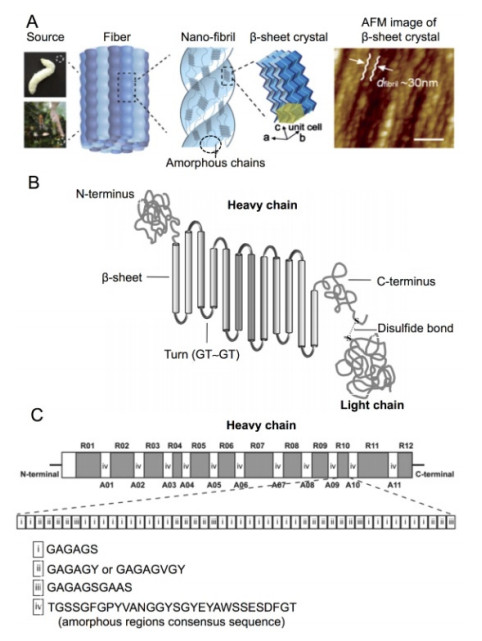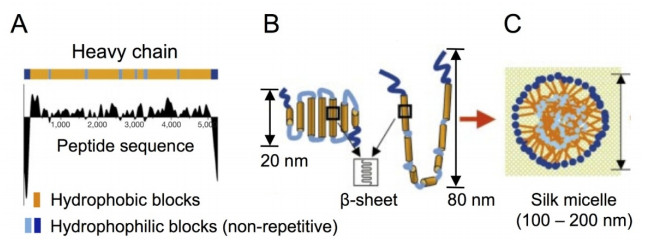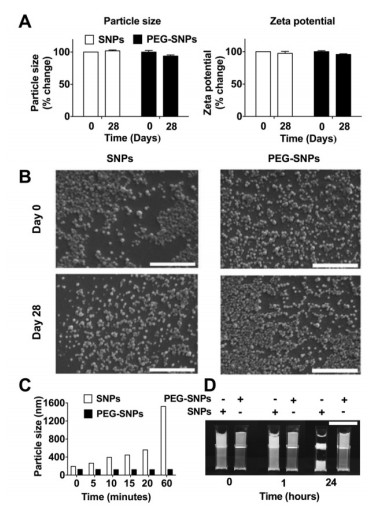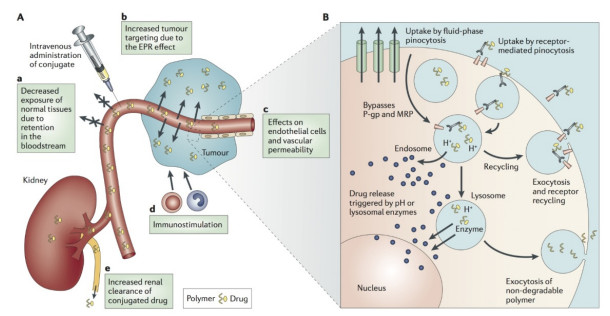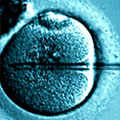1. Introduction
Silk is a sustainable and ecologically friendly biopolymer that can be manufactured from renewable resources [1]. For example, silk worm-derived silks contribute to an overall reduction in atmospheric CO2 due to the need to cultivate mulberry trees for the leaves required to rear the worms. Typically, each silk worm needs 30 g of fresh leaves to meet its 10, 000-fold increase in body weight, after which it spends 72 hours spinning the up to 1500 m long and 20 mm thick single silk thread that forms its cocoon. Over five millennia, humans have perfected sericulture (i.e. silk farming), so that the global silk production is now 100, 000 tonnes per annum. Silk has been used in textiles for thousands of years [2] and as a suture material for many centuries [3]. Humans have long appreciated the mechanical strength, toughness and elasticity of silk fibres; these properties arise from the unique hierarchical structure of the fibre [1,4,5,6].
Since the 1990s, we have seen a tremendous development of both bottom-up and top-down approaches for the generation of silk (inspired) biopolymers [4]. Specific critical developments have included reverse engineering of silk cocoons and the advent of recombinant technologies, which have supported the exploitation of silk materials for use in a broad range of applications while reaffirming the uniqueness of in vivo-derived silk fibres [1,7]. For example, the remarkable properties of silk have supported high-end applications, such as its use in parachute cords [8], bulletproof vests [9], composite materials for the aviation industry [10], artificial silk fibre spinning [11], all-water-based microfabrication procedures [12], and silk-based photonics [13], electronics and sensors [14], as well as edible food packaging [15,16] and in vitro tissue and disease models [17]. Regulatory authorities across the globe have approved Bombyx mori silk fibres for load-bearing applications in humans. This usage has served as a springboard for the exploration of silk for a range of medical applications, such as tissue engineering [18,19] and drug and cell delivery [20,21].
Overall, silk is remarkable because it can be (ⅰ) stronger than steel and tougher than Kevlar, (ⅱ) processed in all an aqueous environment, (ⅲ) readily formulated into many different formats (e.g. fibres, films, scaffolds, hydrogels, microparticles, nanoparticles, etc.) (Figure 1) [22], and (iv) generally regarded as biocompatible and biodegradable[23]. Furthermore, silk can protect therapeutic payloads, such as low molecular weight drugs (e.g. antibiotics), macromolecules (e.g. antibodies, enzymes) [24] and cells [22]. These unique features have supported a staggering array of applications that exploit this biopolymer.
Over the past 5 years, we have witnessed an increasing number of studies that have examined the potential of silk as a drug delivery intermediary, often in the context of cancer. For example, encouraging results have been obtained with in vivo focal therapy of human orthotopic breast cancer and neuroblastoma using cytotoxic chemotherapy and precision medicines using silk films [22,25,26] and self-assembling silk hydrogels [27,28]. The experimental findings now warrant the development of second-generation materials. Clinical experience demonstrates that focal therapy of solid tumours is critical in improving patient outcomes in the long term; therefore, a strong demand exists for locally applied drug delivery systems that can support therapy (reviewed in [29]).
However, patient survival is poor once disseminated disease is diagnosed [30], because metastasis is responsible for 90% of the mortality of patients with solid tumours [31]. Therefore, targeting a therapeutic payload to a (metastatic) solid tumour is an appealing strategy; a concept conceived and championed by Paul Ehrlich more than 100 years ago [32]. Nanoparticles have emerged as a potential platform for drug targeting. Here, we review silk nanoparticles in the context of anticancer drug delivery and assess some of the current opportunities and challenges. Many excellent reviews covering silk for drug delivery in general [20,21], as well as the manufacture of silk nanoparticles in particular [33,34], already exist.
For this review, we refer to silk in generic terms, defining silks as protein-based fibre-forming materials spun by living organisms [1]. Spiders and silkworms are the most prominent organisms associated with silk production [35]. Where appropriate, we distinguish between silkworm silk spun into cocoons by Bombyx mori versus spider silks and between silk materials that are reverse-engineered native proteins and those generated in heterologous hosts via genetic engineering: an approach typically used to generate materials inspired by spider silks [35]. Importantly, sericulture allows the manufacture of large amounts of high quality silk. By contrast, spiders produce inferior silk when the organisms are held in captivity and they display cannibalistic and territorial behaviours, which preclude spider silk farming [10]. For this reason, silk cocoons from Bombyx mori are most widely used when exploring the silk designs for drug delivery.
2. The Structure of The Silk Biopolymer
The structure of B. mori silk is detailed to provide a basis for this review (Figure 2). The reader is pointed to excellent recent reviews for further details on the structure [35,36] and mechanical properties [5,6] of spider silk.
The B. mori silk consist of a heavy chain (approximately 360 kDa) and a light chain (approximately 26 kDa), which are held together by a single disulphide bond [38,40] (Figure 2b). The silk light chain has completely non-repeating amino acid sequences, indicating that this subunit adopts a globular confirmation (Figure 2b). The silk heavy chain is responsible for the remarkable physical properties of silk; this chain consists predominantly of five amino acids: 46% glycine (G), 30% alanine (A), 12% serine (S), 5% tyrosine (Y) and 2% valine (V) and only 4.6% of the other 15 protein amino acids [41]. The properties of silk arise from the unique amphiphilic protein structure of its heavy chain, which includes 12 hydrophobic domains that account for 94% of the chain. These domains are interspaced by 11 hydrophilic regions that contain negatively charged, polar, bulky hydrophobic and/or aromatic residues that share a common consensus sequence (Figure 2c) [38,40]. The heavy chain is capped with hydrophilic C-and N-terminal sequences; these sequences consist of completely non-repeating amino acid residues. The hydrophobic blocks of the heavy chain contain highly repetitive glycine-X repeats, where X is alanine (A) (65%), serine (S) (23%) or tyrosine (Y) [42], and these blocks account for 94% of the silk heavy chain sequence [41]. The hydrophobic blocks can be classified into three motifs: (ⅰ) a highly repetitive GAGAGS sequence making up the bulk of the crystalline regions and typically found at the start of each block; (ⅱ) a less repetitive sequence containing hydrophobic and/or aromatic residues GAGAGY, GAGAGV and GAGAGVGY, making up the semicrystalline regions; and (ⅲ) sequences very similar to (ⅰ) except for the presence of an AAS motif, which is usually found at the C-terminal end of each subdomain and may form a "sheet-breaking" motif [40] (Figure 2c).
This primary structure can adopt random coils, b-sheets, a-helices and turns. The hydrophobic domains can form crystalline anti-parallel b-sheets joined by hydrogen bonds [40]; these give silk its remarkable mechanical strength, while the abundance of these secondary structures determines its stability and mechanical properties. For example, structural analysis of native silk fibres reveals the presence of small b-sheets crystalline units (approximate dimensions 21 × 6 × 2 nm) embedded in an amorphous matrix (Figure 2a). When the fibre is stretched, a gradual alignment occurs along the fibre axis, followed by entanglement and ultimate breakage of covalent bonds [40].
In nature, two distinct structures of B. mori silk are recognized: Silk Ⅰ represents the structure during storage and before spinning (i.e. the liquid silk dope stored in the silk gland), whereas Silk Ⅱ represents the structure occurring after spinning into the silk fibre [40]. The block copolymer arrangement of silk drives the formation of spherical micellar structures, 100-200 nm in size, which contain a hydrophobic core of crystalline/amorphous domains and a hydrophilic shell of the terminal domains [43,44] (Figure 3). These micelles remain loosely assembled, and the assembly process is reversible [45]. However, a number of external triggers, such as stretching, shearing, or changes in solution concentration, pH or ionic strength, cause irreversible physical crosslinking at the intermicellar and interglobular levels [20]. The resulting silk has an increased β-sheet content and forms networks through a self-assembly process, thereby eliminating the need to use any harsh chemicals or crosslinkers.
The self-assembly of silk into micellar structures and the responsiveness of these structures to external stimuli is exploited when generating silk nanoparticles. For example, an aqueous silk solution can be added to a miscible organic solvent, such as acetone, or a salt solution can be added to a silk solution (salting out) to cause nanoprecipitation (detailed below). Both these procedures give rise to nanoparticles that are characterised by high crystallinity in their densely packed cores.
3. Manufacture of Silk Nanoparticles
A broad spectrum of manufacturing strategies has been used to generate B. mori silk nanoparticles (reviewed in [33,34]), including poly (vinyl alcohol) blends (particle size range 300 nm to 10 μm) [46], emulsification (170 nm) [47], capillary microdot printing (25 to 140 nm) [48], salting out (486 to 1200 nm) [49], organic solvent precipitation (35 to 170 nm) [50,51,52,53], supercritical fluid technologies (50 to 100 nm) [54], ionic liquids (180 nm) [55], electrospraying (59 to 80 nm) [56], fibrational splitting of a laminar jet (particle size range up to 400 μm) [57], electric fields (200 nm to 3 μm) [58] and milling technologies (200 nm) [59]. A further proposition has been the use of payload mediated nanoparticle formation via the induction of β-sheet-rich, barrel-shaped nanoparticles [60], but this requires formal experimental verification. The formation of stable silk nanoparticles typically requires a change in the silk conformation from a random coil to physically crosslinked β-sheets through increased protein-protein packing by the removal of solvating water; silk nanoparticle formation using organic solvents and salting out are based on this principle. However, in the absence of these tightly packed β-sheets, only metastable nanoparticles are generated and these require further processing to generate stable particles [33,34]. Metastable nanoparticles can be produced by applying electric fields [58] or by a modified silk fibre dissolution process that enables in situ particle formation [61].
4. Structure Function Relationships of Silk Nanoparticles
The secondary structure of silk nanoparticles is expected to impart marked differences in nanoparticle performance, as seen, for example, in comparisons of amorphous silk nanoparticles and those prepared using acetone desolvation [61]. Both nanoparticle populations show a similar size and ability to adsorb and release doxorubicin in response to environmental pH. However, the amorphous silk nanoparticles showed a significantly smaller zeta potential when compared to acetone desolvated silk nanoparticles. Amorphous silk nanoparticles were stable in water for days but were responsive to ions, and they changed into silk fibrils within hours when transferred to PBS pH 7.4 [61]. By contrast, the physically crosslinked silk nanoparticles remained stable under this condition [51,61,62]. These morphological changes observed in the amorphous silk nanoparticles are expected and interesting, but they become problematic for the development of silk nanoparticles for drug delivery applications, and particularly for intravenous administration, because these particles are unstable under physiologically relevant conditions.
5. Surface Modification of Silk Nanoparticles
Physically crosslinked silk nanoparticles can be surface modified with an active targeting residue and/or surface grafted polymers to improve particle performance (e.g. colloidal stability, ability to evade the immune system, increased circulation time in the blood, etc.). For example, silk nanoparticles were activated using standard 1-ethyl-3-(3-dimethylaminopropyl) carbodiimide (EDC) and N-hydroxysuccinimide (NHS) coupling chemistry to generate 2, 2-(ethylenedioxy) bis (ethylamine) modified silk nanoparticles [63]. These functionalised silk nanoparticles were subsequently reacted with folic acid to yield folate receptor-targeted silk nanoparticles that showed improved in vitro cell uptake. Targeting residues are often tethered via polymeric linkers to improve receptor-binding affinity and for further enhancement of endocytic uptake; therefore, the effects of sophisticated conjugation strategies on silk nanoparticle targeting capabilities remain to be established both in vitro and in vivo. In particular, the design of nanoparticles for in vivo applications typically requires "stealth" technologies to avoid non-specific uptake by the mononuclear phagocytic system (MPS) [64]. Surface decoration with polyethylene glycol (PEG) is a frequent choice for modification of macromolecular drug carriers such as nanoparticles [64,65]. We recently reported that the PEGylation of silk nanoparticles dramatically improved their stability in physiological relevant conditions by eliminating particle aggregation (Figure 4) and preventing cytokine release from macrophages. Interestingly, PEGylated silk nanoparticles accelerated the pH-dependent release of doxorubicin [62].
An alternative to covalent modification of silk nanoparticles is surface modification using charge-charge interactions. Silk nanoparticles are negatively charged and are therefore typically complexed with positively charged polymers, such as glycol chitosan, N, N, N-trimethyl chitosan, polyethylenimine and PEGylated polyethylenimine [66]. Silk nanoparticles modified with PEGylated polyethylenimine showed a particularly improved stability in diluted PBS and cell culture medium [66].
6. Magnetically Targeted and Engineered Spider Silks
In addition to surface modification of silk nanoparticles, targeted silk nanoparticles have been manufactured using a one-step manufacturing protocol [67]. Briefly, doxorubicin was surface adsorbed to magnetic Fe3O4 nanoparticles and these nanoparticles were suspended in potassium phosphate buffer (1.25 M, pH 8). An aqueous silk solution was then added to the system and the silk salted out as drug-loaded magnetic nanoparticles 130 nm in size. These silk nanoparticles would respond to a magnetic field and showed significantly improved tumour accumulation and subsequent anticancer effectiveness when compared to untargeted silk nanoparticles loaded with an equivalent amount of doxorubicin [67].
Spider silk mimetics have also been generated using of genetic engineering tools (reviewed in [10,68]). Here bespoke recombinant model proteins are generated to mimic key features of spider silk (e.g. the major ampullate silk used as the outer frame and radii of the web, as well as the spider's "lifeline"; this silk has remarkably high tensile strength and an unprecedented toughness when compared to other fibres) [4,9]. In addition, the recombinant proteins can be designed to incorporate functional groups for improved delivery and cellular recognition. For example, Thomas Scheibel and co-workers have pioneered the formation of mimetic spider silk nanoparticles using salting out techniques [69]. Typically, their work is inspired by Araneus diadematus fibroin 4 (ADF-4) silk spun by the common European garden spider, but their recombinant spider silk protein eADF-4 (C16) (47.7 kDa) consists of 16 repetitions of the C-module (GSSAAAAAAAA-SGPGGYGPENQGPSGPGGYGPGGPG), mimicking the highly repetitive core sequence of ADF-4 [70]. These basic building blocks can then be readily modified to incorporate cell binding motifs (e.g. RGD), cell penetrating peptide sequences (Tat) and polycations by replacing all the glutamic acid residues of the ADF-4 with lysines [71]. Their eADF-4 (C16) nanoparticle libraries have been extensively assessed for their ability to entrap and release model and therapeutic payloads, to uncover physico-chemical relationships [69] and to be taken up by cells [71,72,73].
In addition to ADF-4 engineered silks the major ampullate spidroin 1 (MaSp1) from the Gold Orb weaver spider (Nephila clavipes) has been used to generate targeted silk nanoparticles. For example, a 15mer based on the MaSp1 consensus sequence was combined with a Her2/Neu tumour targeting residue and was then successfully salted out into 400 nm sized spherical nanoparticles and loaded with doxorubicin. These particles showed superior cell uptake and in vitro cytotoxicity when compared to non-targeted nanoparticles [74]. However, the performance of these particles in tumour bearing animal models remains to be established.
7. Mechanical Properties of Spider Silk Particles
Atomic force microscopy studies of single eADF-4 (C16) particles have revealed that the dry particles showed plastic deformation and an increased elastic modulus with ongoing deformations [75]. The hydrated particles doubled their volume and softened significantly, resulting in an elastic modulus three orders of magnitude lower than in their dried state (2.99 MPa ± 0.90 MPa versus 0.8 GPa ± 0.5 GPa). The hydrated silk particles also showed no mechanical fatigue, unlike the dried particles. The use of different crosslinking techniques, as well as changes in silk primary sequence, allow fine-tuning of the mechanical properties of eADF-4 (C16) particles [75]. The mechanical characteristics of the eADF-4 (C16) particles are important during processing, handling and storage. However, nanoparticle mechanics can also influence biological functions, such as blood circulation time and endocytic uptake [76], and these effects remain to be elucidated for eADF-4 (C16) nanoparticles.
8. Engineered Spider Silk Nanoparticles for Gene Delivery
Keiji Numata, David L. Kaplan and co-workers developed recombinant silks for gene delivery (reviewed in [77]) using the consensus sequence from the dragline protein of MaSp1 [78]. Here, a 6mer of the sequence SGRGGLGGQGAGAAAAAGGAGQGGYGGLGSQGT was followed by variable lengths of lysine residues responsible for DNA complexation. A silk library with 15, 30 and 45 lysine residues was generated; the dimer (30 lysines) formed 380 nm polyplexes and gave the best transfection efficiency. Evolution of these spider silk-inspired vectors, including the addition of either RGD binding sites [79] or the cell penetrating peptide pTG1 [80], further improved transfection efficiency. The development of block copolymers with a Histag, followed by the silk 6 mer, a 30 residue long lysine sequence and the monomeric F3 peptide for tumour targeting, gave rise to a recombinant silk that showed superior in vitro transfection efficiency when compared to Lipofectamine. This recombinant silk also gave encouraging, but preliminary, results in an orthotopic human breast cancer model [81].
9. Biocompatibility and Biodegradation
The biocompatibility and biodegradation of silk has been reviewed elsewhere [22,23]. Overall, silk is typically well tolerated, and silk sutures and surgical meshes are approved for use in humans. The excellent clinical track record of silk for load bearing applications give silk a wide recognition as a "biocompatible" biopolymer for virtually all biomedical applications. Nonetheless, the generic use of the term "biocompatibility" to describe all silks, including silk-inspired materials, is potentially misleading. In particular, the notion that any natural material automatically qualifies as biocompatible is widespread, but remains to be supported by scientifically rigorous data. Context-specific biocompatibility assessment is still required when silk is used beyond its licensed applications. For example, we have recently assessed the haematocompatibility of macroscopic silk films [82,83] because silk has been proposed for various vascular tissue engineering applications despite the current lack of rigorous blood compatibility assessments. These blood studies indicated minimal coagulation but substantial complement activation.
The direct transfer of the results obtained from macroscopic surfaces to nanoparticles is not appropriate because of specific and non-typical interactions of nanoparticles with blood. Furthermore, the haematocompatibility requirements for nanoparticles appear even more stringent in the blood circulation than for solid surfaces because any incompatibility reaction of systemically administered nanoparticles would affect multiple organs. Blood compatibility of silk nanoparticles is important because their intravenous dosing is the expected route of administration when treating solid tumours. However, blood compatibility of native and modified silk nanoparticles, as well as reference nanoparticles is currently a critical gap in the literature.
10. The Challenges with Silk
Although silk has numerous advantages over other (bio) polymers, working with this material poses a number of challenges. One disadvantage is that silks have relatively simple functional groups that offer limited options for chemical modification [84]. In addition, the silk from the domesticated silkworm (Bombyx mori) lacks cell-instructive cues (e.g. RGD sequences for cell adhesion, peptide sequences for targeting) although this can also be regarded as advantageous as it permits the full control of the degree of silk functionalisation (using chemical modifications).
Unlike B. mori silk, the silk from the wild silkworm (Antheraea pernyi) has a natural abundance of RGD sequences in its backbone. However, the yields of A. pernyi silk cocoons are low, making this insect unsuitable for commercial sericulture. Genetic modification of B. mori is therefore emerging as a valuable strategy for the development of designer silks (e.g. silks with RGD sequences) [85], as well as for exploitation of the exquisite capabilities of genetically modified silkworms to biosynthesise chimeric silks [86]. Both silkworm and spider silks have very large molecular weights and high glycine contents-features which preclude the faithful recombinant expression of these silks in common heterologous hosts [22]. However, the use of E. coliwith an elevated glycyl-tRNA pool is one successful strategy for the development of native-sized recombinant spider silks [87].
Silk cocoons are often used as a raw material when developing novel nanomedicines. However, silk cocoons present a number of manufacturing challenges; for example, sericulture is (ⅰ) an agricultural process and thus dependent on seasons/climate (e.g. high quality mulberry leaves, pest control, etc.), (ⅱ) labour intensive, and (ⅲ) a batch process. Furthermore, sericin removal is required if the silk cocoon is intended for biomedical applications (i.e. to minimise the inflammatory response) [3]. This necessitates a degumming process (for removal of sericin) that typically damages the silk structure, increases the polydispersity of the reverse engineered silk solution [88] and thereby complicates quality control. Furthermore, the resulting degummed silk has a tendency to aggregate when stored over long periods as an aqueous solution (weeks at room temperature and months at 4 ℃) [89].
11. Nanomedicines
The term "nanomedicine" was coined in the early 2000s and is essentially an umbrella descriptor for specifically engineered, multi-component, nanosized drugs and drug delivery systems [90]. Nanomedicines have unique characteristics that improve drug performance, including increased drug bioavailability and residence time in the blood. Nanomedicines also enable payload targeting to a specific location in the body, while overcoming drug resistance mechanisms [90]; early proof of concept data is available for silk nanoparticles [51,67]. Furthermore, the use of a nanosized drug delivery system endows the payload (or even payload combinations) with a predesigned whole body, organ, cellular, and subcellular pharmacokinetic profile. Overall, nanomedicines are emerging as a promising approach for the treatment of a number of diseases, including cancer [91]. The use of particulate nanoparticles for drug delivery was first proposed in the 1970s [90]. However, it took 3 decades for the first and only protein-based nanoparticle (Abraxane, paclitaxel-bound albumin) to reach the market, largely due to the challenges faced in scale-up, batch-to-batch reproducibility and regulatory compliance [90]. The success of Abraxane in navigating these challenges inspired a revival in the use of nanoparticles for drug delivery over the past decade [92]. More importantly, it has sparked refinements in existing nanoparticles and the inception of novel production processes, as well as the assessment of novel polymers, including silk. One might speculate that recombinantly engineered silk nanoparticles are especially well placed to meet regulatory approval because similar manufacturing processes are already used for therapeutic proteins.
12. Exploiting Tumour Pathophysiology with Nanomedicines
Nanoparticles are particularly well suited for tumour targeting because they can exploit the leaky neo-vasculatures and poor lymphatic drainage of solid tumours, resulting in passive nanoparticle accumulation (Figure 5) [93]. This phenomenon, termed the enhanced permeation and retention (EPR) effect, is typically the basis for the design of nanoparticles for anticancer drug delivery via intravenous dosing. Inclusion of targeting ligands can further enhance the specificity of these nanoparticles. For example, magnetic guided silk nanoparticles showed a 4-fold improvement in tumour targeting when compared to unguided particles. Magnetic guiding reduced tumour growth 3-fold and significantly improved survival over the 30 day study period [67]. Furthermore, the use of drug loaded silk nanoparticles significantly improved the pharmacokinetics of the payload when compared to the free drug, although more than 95% of the drug was still lost from the plasma within 4 hours of intravenous dosing. Despite magnetic targeting, the vast majority of these silk nanoparticles (and their drug payload) accumulated in the liver [67]. In addition, the exact distribution of these silk nanoparticles within the tumour microenvironment, in the target cell population and within intracellular locations was not determined.
For many reasons, the translation of nanoparticle research into the clinic has been disappointing slow [95,96]. Some complicating factors have included the assumption of a ubiquitous EPR effect, gross oversimplification of tumour biology (e.g. by disregarding tumour heterogeneity and using irrelevant tumour models) and an excessive commercial interest by academic laboratories that results in conflicts of interest. Studies using the nanoparticles designed over the past decade typically show that only 0.7% (median) of the administered nanoparticle dose reaches the tumour, clearly indicating the limitations of current designs [97]. However, new strategies for the field are being proposed [97]; for example, better stratification of patients who are EPR positive through the use of pre-treatment imaging of the EPR extent [92]. These improvements should enhance our understanding of clinically relevant tumour pathophysiology and enable better nanomedicine designs. Overall, nanoparticles designed for solid tumour targeting and intravenous administration must successfully exit the blood circulation at the tumour site, accumulate in the tumour microenvironment, target the correct cell population (s) and trigger payload release (Figure 5). Those nanoparticles designed for intracellular activation must successfully complete their journey to the correct intracellular destination to achieve the desired outcome (Figure 5b).
13. The Importance of the Intracellular Trafficking of Nanomedicines
Comparatively little is known about the intracellular fate of nanomedicines [98,99], and the broad spectrum of applications results in widely differing payloads among various nanomedicines [91,92]. For example, achieving the desired therapeutic effect of different payloads (e.g. therapeutic proteins, genetic material or chemotherapy) that are designed for intracellular activation often requires that the payload not only reach the target cell but also be delivered to a specific intracellular compartment [92,98,99,100].
A major reason for the current failure in the development of nanomedicines for clinical use (e.g. nanoparticles, polymer-drug conjugates, and vectors for genetic manipulation and proteins) is a lack of quantitative studies that have monitored the intracellular fate of nanomedicines following delivery. This is a major obstacle that still prevents the verification of non-clinical proofs of concept and this verification is further complicated by the inadequate safety profiles available for patients [90,99]. Qualitative assessment, and particularly the quantitation of intracellular trafficking, is critical when developing carriers that are designed for delivery by endosomotropic (delivery to the endosomal compartments of the cell) or lysosomotropic (routing to lysosomes) routes [94,99,100]. Lysosomal targeting of a number of linear, water soluble polymers (e.g. dextran, dextrin, N-(2-Hydroxypropyl) methacrylamide etc.) is well documented [99]. However, quantitative data are scarce for the newer polymers and are lacking for silk nanoparticles, while similar qualitative data for silk nanoparticles are rudimentary and often flawed.
14. Endocytosis and Exocytosis: Movement of Nanomedicines into and out of Target Cells
Nanomedicines, including silk nanoparticles, are actively taken up into cells through the process of endocytosis. Cells have multiple entry portals; the most common uptake mechanisms involve clathrin-coated pits, caveola and macropinocytosis [98,99]. Lipid rafts can also contribute to caveola-mediated and non-caveola-mediated uptake mechanisms. Theoretically, nanomedicines can gain cellular access through any of these routes; however, receptor targeting, geometry [101,102] or the formation of aggregates often dictate the actual uptake route (s) [103].
The predominant entry point into cells also tends to be cell-type specific. For example, aminopeptidase-targeted nanoparticles are transported within seconds from the blood circulation, across the endothelium, and into lung tissue via a caveola-dependent mechanism [104]. Specific intracellular compartments are also critical to this process; for example, folate receptor internalisation and subsequent recycling into the plasma membrane is facilitated by endosomes (heterogeneous organelles with a sorting and recycling function) [105]. The study of intracellular trafficking of nanomedicines must therefore take into account the complexity of endocytosis and cell type peculiarities [106]; however, this has so far been ignored when studying silk nanoparticle trafficking.
However, many agents are designed for specific "targets", such as late endosomes, lysosomes or the cytosol. Continuous retrograde trafficking of vesicles, which either fuse with the plasma membrane (exocytosis) or pinch off (exosomes), provides a further trafficking route for nanomedicines. Determination of cellular kinetics therefore requires that both cellular uptake and release be monitored for the calculation of an absolute endocytic index [99]. Limited endocytic uptake, inadequate cytosolic transfer, or perturbations of vesicle fusion/maturation by the mere presence of the nanomedicine inside the cell are potential pitfalls associated with nanomedicine design. There is currently no data available how silk nanoparticles impacts the endocytic machinery.
15. Intracellular Trafficking of Silk Nanoparticles
A number of preliminary studies are now tracing the intracellular fate of silk nanoparticles in vitro using flow cytometry and fluorescence microscopy. For example, a small library of eADF-4 (C16) silk nanoparticles functionalised with Tat, RGD or lysine has been developed for this purpose [73]. As expected, the cationic lysine silk nanoparticles (300 nm diameter) showed the largest cell-associated fluorescence. In addition, the use of putative chemical inhibitors suggested a clathrin-mediated uptake mechanism into HeLa cells. However, the absence of biochemical validation demonstrating the specificity of these chemical inhibitors, the lack of live-cell single-plane confocal microscopy examinations and the limited data showing extracellular binding and estimating overall endocytic index preclude drawing any robust conclusions regarding the trafficking of silk nanoparticles at this time. Similar considerations apply to studies examining various payload-modified spider silk nanoparticles [71]. Nonetheless, the uptake route of silk nanoparticles into MCF7 human breast cancer cells also appeared to be clathrin mediated [67]. However, chlorpromazine, a widely used chemical inhibitor, has many off-target effects [107]. Therefore the specificity of chlorpormzine needs to be verified first before drawing conclusions in relation to uptake pathway (s) of silk nanoparticles. Rigorous verification includes, for example the assessment of chlorpromazine on transferrin uptake. Transferrin is internalised via clathrin-mediated endocytosis and is thus an exquisite biochemical probe for studying clathrin-mediated endocytosis [107]. Overall, further proof is needed to verify the uptake mechanism of silk nanoparticles into MCF7 cells. Live cell confocal microscopy studies have demonstrated lysosomal accumulation of both native and PEGylated silk nanoparticles approximately 110 nm in size [51,62]. Here, doxorubicin-loaded silk nanoparticles provided the first evidence of lysosomotropic drug delivery [51].
In summary, the available evidence clearly supports the endocytic uptake of silk nanoparticles. However, more advanced endocytosis and trafficking studies are required to generate a comprehensive intracellular trafficking map for silk nanoparticles.
16. Conclusions
Silk nanoparticles are emerging as interesting contenders for drug delivery and are well placed to advance the nanomedicine field. However, in the past, numerous materials, nanoparticle designs and treatment strategies have been heralded as "break-through" and "paradigm-shifting" advancements in the nanomedicine field [95,96], but the slow clinical translation of nanoparticle research is a clear indicator that the enthusiasm, hopes and aspirations are not matching up with reality [97]. At present, the foundations of solid tumour targeting based on nanoparticles appear to require further substantiation. Thus, for silk to succeed in this field, we need to learn from past failures while introducing inventive and orthogonal approaches to nanoparticle research.
Acknowledgements
This research was supported in part in part though a TENOVUS Scotland Grant S13/8, a Royal Society Research Grant RG2014R2, a Marie Curie FP7 Career Integration Grant 334134 within the seventh European Union Framework Program and an EPSRC First Grant EP/N03127X/1.
Conflict of Interest
The author declares no conflicts of interest in this review.









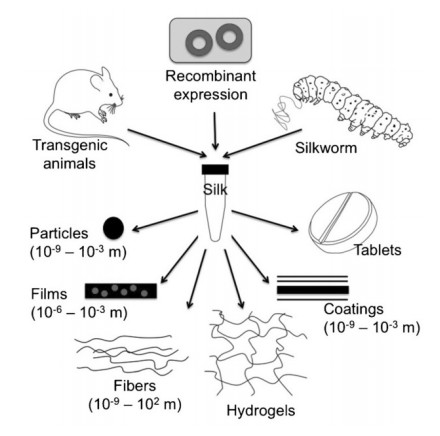
 DownLoad:
DownLoad: 